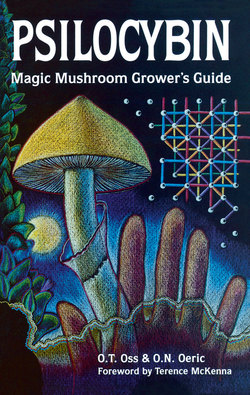Читать книгу Psilocybin: Magic Mushroom Grower's Guide - O.T. Oss - Страница 13
На сайте Литреса книга снята с продажи.
ОглавлениеSTEP I:
LOCATING AND IDENTIFYING THE FUNGUS: COLLECTING AND GERMINATING SPORES
In the New World, Stropharia cubensis can be found in appropriate habitats throughout the Southern U.S., all through the coastal regions of Mexico, and throughout coastal and equatorial regions of South America. In the U.S., it has been reported from Texas, Louisiana, Alabama, Mississippi, Arkansas, Florida, Tennessee, and Georgia. Its distribution would probably be even greater were it not for the fact that its environmental requirements limit it to regions of mild temperatures and high humidity.
Because of its specific habitat and singular appearance, Stropharia cubensis is one of the easiest mushrooms to locate and identify. As already mentioned, it can be found growing out of cow-pies in pastures during rainy warm seasons. Other dung-growing mushrooms may also be found in the same pasture, but these bear little resemblance to Stropharia. The following botanical description of Stropharia cubensis is taken from Mushrooms of North America by Orson K. Miller, Jr.:
Cap pale yellowish, viscid; persistent ring; blue-staining stalk.
Cap 1.5-8 cm broad, conic, bell-shaped, convex in age, viscid, without hairs, whitish to pale yellow, light brownish in age, stains bluish in age. Flesh firm, white, bruises blue. Gills adnate(attached) to adnexed(notched), close, grey to violet-grey in age with white edges. Stalk4-15 mc long, 4-14 mm thick, enlarging somewhat toward the base, dry, without hairs, white staining blue when bruised. Veil white, leaving a superior membranous ring. Spores 10-17μ x 7-10μ elliptical to oval in side-view, thick-walled, with a large pore at apex, purple-brown spore print. Cystidia (sterile cells) on gill edge club-shaped with rounded heads.
Miller places this species in the genus Psilocybe, after Singer.
The flesh of this mushroom exhibits the property of staining a bluish color when bruised or broken. This blue- staining reaction is apparently an enzymatic oxidation of psilocin to an indole diquinone (Bocks, 1967) and is a fairly reliable indicator of the presence of psilocybin, not only in Stropharia cubensis, but also in other closely related genera (members of the family Strophariaceae) (cf. Benedict, et al., 1967). Other mushrooms, such as members of the genus Russula, section Nigricantinae, and Boletus, exhibit a similar blueing. The blueing in these cases, however, is not due to the presence of indole substrates and these mushrooms otherwise bear no resemblance whatever to Stropharia cubensis or related species (Singer, 1958, p. 247).
fig. 2: Sterilizing the slide.
fig. 3: Decapitation
fig. 4: Making spore print (note slide arrangement).
Once one has located a specimen or specimens of Stropharia cubensis, and been satisfied as to its identity in all particulars, it is necessary to collect spores for cultivation. Spores can be easily collected in the following manner: Take one or more fresh specimens with the caps fully open; using a sharp knife, cut off the stipe as close to the gills as possible (see fig. 3) and place the cap gillside down on a clean sheet of white paper, and leave for 24 hours. It doesn’t hurt to cover the caps with a small bowl while taking the spore print in order to prevent dessication. When the caps are removed, a dark-purplish, radially symmetrical deposit of spores will remain on the paper where the gills contacted it. The paper should then be folded and sealed in an envelope in order to prevent further contamination by airborne spores of other species of lower fungi. A single spore-print contains tens of millions of spores, and is sufficient to make hundreds of spore germinations.
The following variation on this method was suggested to us as a way of enhancing the sterility of the spore print: Take four standard flat microscope slides, swab with alcohol, and flame in an alcohol flame or butane torch (fig. 2). On a clean flat surface, such as a table-top swabbed with Lysol, lay the slides side by side and end to end, so that they are arranged as in fig. 3. Place the fresh cap in the exact middle of the slides so that approximately ¼ of the cap covers each slide (fig. 4). Cover and wait 24 hours. When the cap is removed, the end of each slide will be covered with spores, and the slides can then be sealed, together or separately, in plastic or paper. One can easily substitute glass microscope coverslips for the slides to maximize compactness. Do not use plastic coverslips, since static electricity associated with them makes it difficult for the spores to adhere to them.
Once the spore-print has been collected, it is necessary to germinate some spores in order to begin the life cycle that will eventually culminate in the production of more mushrooms. Before we outline procedures for germinating the spores, a brief discussion of the stages in the life cycle of these higher fungi follows; readers who do not care to read this somewhat technical portion may skip the next three paragraphs.
